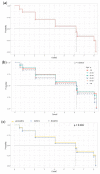A Machine Learning Approach Investigating Consumers' Familiarity with and Involvement in the Just Noticeable Color Difference and Cured Color Characterization Scale
- PMID: 38137230
- PMCID: PMC10743146
- DOI: 10.3390/foods12244426
A Machine Learning Approach Investigating Consumers' Familiarity with and Involvement in the Just Noticeable Color Difference and Cured Color Characterization Scale
Abstract
The aim of this study was to elucidate the relations between the visual color perception and the instrumental color of dry-cured ham, with a specific focus on determining the Just Noticeable Color Difference (JNCD). Additionally, we studied the influence of consumer involvement and familiarity on color-related associations and JNCD. Slices of ham were examined to determine their instrumental color and photos were taken. Consumers were surveyed about color scoring and matching of the pictures; they were also asked about their involvement in food, familiarity with cured ham, and sociodemographic characteristics. Consumers were clustered according to their level of involvement and the JNCD was calculated for the clusters. An interpretable machine learning algorithm was used to relate the visual appraisal to the instrumental color. A JNCD of ΔEab* = 6.2 was established, although it was lower for younger people. ΔEab* was also influenced by the involvement of consumers. The machine-learning algorithm results were better than those obtained via multiple linear regressions when consumers' psychographic characteristics were included. The most important color variables of the algorithm were L* and hab. The findings of this research underscore the impact of consumers' involvement and familiarity with dry-cured ham on their perception of color.
Keywords: JNCD; JND; consumer; delta E; difference; just-noticeable; machine learning.
Conflict of interest statement
The authors declare no conflict of interest. The funders had no role in the design of the study; in the collection, analyses, or interpretation of data; in the writing of the manuscript; or in the decision to publish the results.
Figures






References
-
- MAPA Home Consumption Database. [(accessed on 1 May 2022)]. Available online: https://www.mapa.gob.es/app/consumo-en-hogares/consulta.asp.
-
- Bernués A., Ripoll G., Panea B. Consumer Segmentation Based on Convenience Orientation and Attitudes towards Quality Attributes of Lamb Meat. Food Qual. Prefer. 2012;26:211–220. doi: 10.1016/j.foodqual.2012.04.008. - DOI
-
- Ripoll G., Panea B., Albertí P. Visual Appraisal of Beef: Relationship with CIELab Colour Space. Itea-Inf. Tec. Econ. Agrar. 2012;108:222–232. doi: 10.13140/RG.2.2.25240.19201. - DOI
Grants and funding
LinkOut - more resources
Full Text Sources

